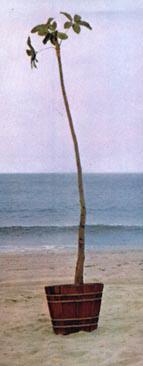
In Jimmy McDonough's excellent biography of Neil Young, the author calls into evidence the recollections of actress Charlotte Stewart, who had been hanging out at drummer Dallas Taylor's house the night of the Manson LaBianca murders. She remembers Steven Stills and David Crosby bursting into Taylor's living room, armed to the teeth, and panicked, too. Howled one of the pair, "they're killing all the people with estates!"
When I first bought On the Beach and first heard "Revolution Blues," I had no idea the song was about Charles Manson. I just knew that I'd rarely heard any vocal performance so scathing and full of bile. Even though the music couldn't have been more different, it still seemed to me that 2 or 3 years before the eruption of British punk, and five or six before the afterbirth that was American hardcore, Neil Young had written a song instructing the kids of the yet unborn genres exactly how the sneering and the snarling should be done.
Even for fans of Black Flag and COC and the rest, it don't get any more antisocial than the lyrical capstone:
Of course, now that I know the song is about Manson, now that I know that Young had written the song from the point of view of Manson, I still think about punk rock, about the mordant black humor in bandnames like Ed Gein's Car or Jodie Foster's Army, or of that bumper sticker I still remember seeing in that record shop on my first trip to New York City: Free Dahmer. |  |
Punk rock knew it took some balls to identify with a psychopath, and knew that they invited revulsion in doing so. The revulsion engendered was actually the point. And while it might be hard to say that Young was inviting revulsion by writing "Revolution Blues," the phrase "willfully perverse" does come to mind. But Young was already in The Ditch, and once he'd put out a record that resembled career suicide as much as Time Fades Away did, the risks in writing a song like "Revolution Blues" couldn't have seemed that much more dangerous.
 David Crosby played rhythm guitar on the record, but the song clearly spooked him. When Young suggested that CSNY play the song on one of their stadium tours, Crosby fought him over it. Young told McDonough that Crosby "didn't think it was safe to do it. Didn't want people to get the message, y'know, about rock and roll stars being worse than lepers. Heh heh. Didn't want that vibe out there."
David Crosby played rhythm guitar on the record, but the song clearly spooked him. When Young suggested that CSNY play the song on one of their stadium tours, Crosby fought him over it. Young told McDonough that Crosby "didn't think it was safe to do it. Didn't want people to get the message, y'know, about rock and roll stars being worse than lepers. Heh heh. Didn't want that vibe out there."Neil Young, however, I guess, was comfortable with it, comfortable with the apocalyptic imagery that almost seems as if it were copped from the Book of Revelations. Comfortable with the bloody fountains, comfortable with the ten million dune buggies comin' down the mountains. Comfortable, and pretty courageous, actually, as he gleefully put his own forehead squarely in the crosshairs.
Neil Young - On The Beach - 3 - Revolution Blues.mp3
This file was removed March 9, 2009. If you're still way interested in coming up with a copy of this--and really can't figure out where you might get one--drop me an email and I'm sure I'll be able to figure something out for you.
File under: Ditch Music














2 comments:
spooky. very, very spooky
Courageous indeed, and man, it's such a driving rhythmic outlet for such an over-the-top persona that you can't help but shake it like a demonic mofo and sing every demented word, hehheh
Post a Comment